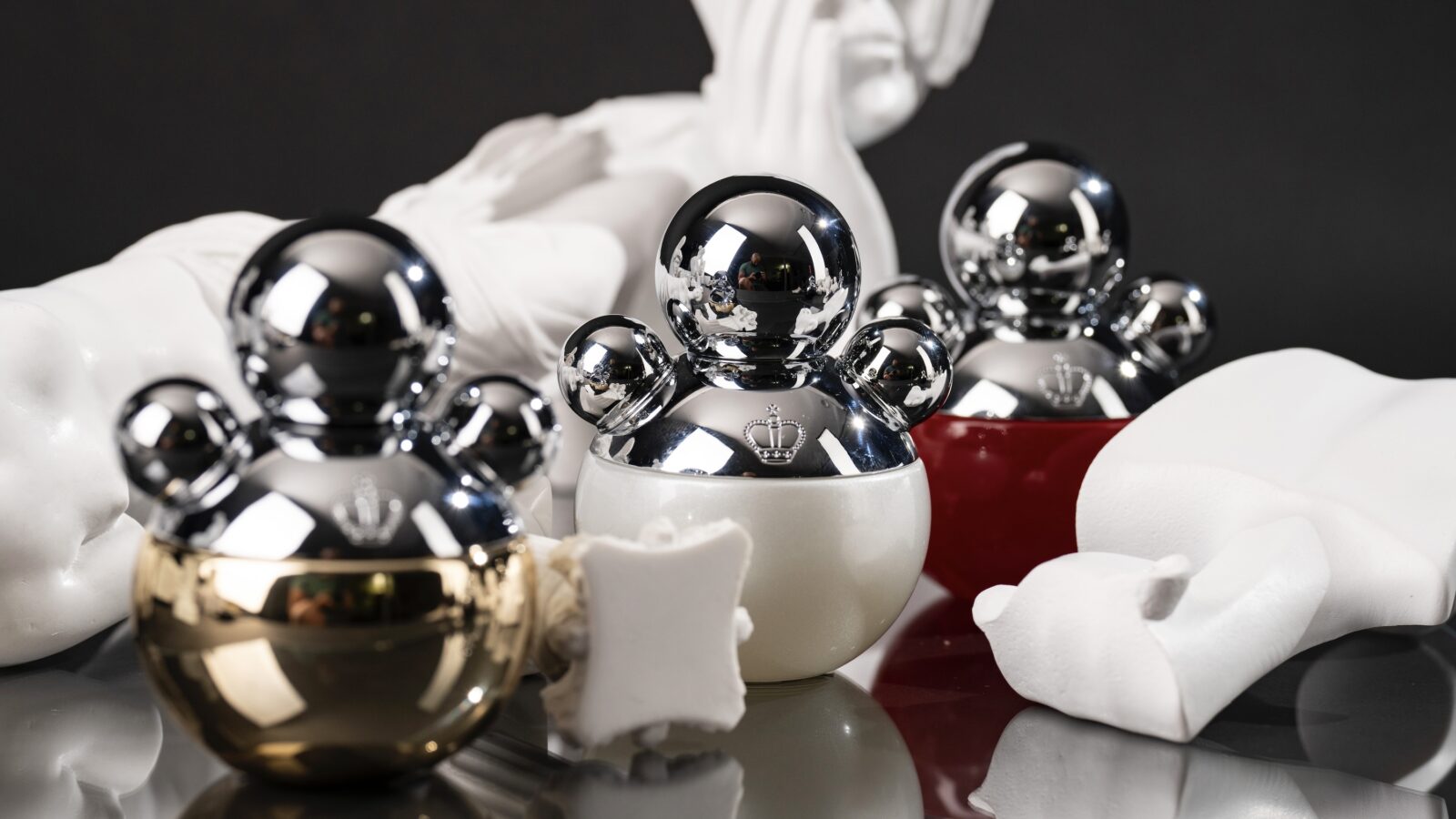

IRFE Ingredient Sustainability Stories
The IRFE fragrance collection consists of 5 Eau de Parfum Fragrances, as listed below. The ingredients used in the IRFE fragrances are part of the Firmenich NATURALS TOGETHER program which includes the following descriptions: -CERTIFIED ORIGIN: Ingredient sourced from certified geographical (country of) origin. -SUSTAINABLE PRACTICES: All ingredients are responsibly sourced ingredients recognized for their high quality rating.
Marshmallow Musk Eau de Parfum
Perfumer Alexis Grugeon from DSM Firmenich on creating the scent for the Marshmallow Musk Eau de Parfum
Sustainable Ingredients:
-Ambrox® Super – Elegant amber note with musky and woody tonalities that releases a sensual warmth Drived through White Biotechnology, Amber is a family of ingredients with a long history and legacy. By 1930, Firmenich discovered AMBROX® from ambergris, in an effort to uncover its natural essence. By 2016 we invented AMBROX® SUPER via the revolutionary white biotechnology. Sparklingly sensual, AMBROX® SUPER offers musky and woody tonalities to amber ingredients. -Helvetolide® – Conveys richness and warmth felt at all levels of the fragrances with pear-like facets and smooth ambrette undertones. Derived by Upcycling ingredients: Firmenich uses the upcycled Turpentine extracted from the paper industry, often those that use softwood to manufacture cardboard. Derived originally from softwoods, this ingredient is sustainable to the earth.
Patchouli Forever Worn Eau de Parfum
Perfumer Frank Voelkl from DSM Firmenich on creating the scent for the Patchouli Forever Worn Eau de Parfum
Sustainable Ingredients:
-Cedarwood Virginia USA EO Super – A beautiful woody note that offers a contrast of dry notes facetted with warm yet sweet sandalwood undertones. An ingredient derived from Upcycling In the USA, the Cedarwood Virginia is primarily employed to build closets that keeps bugs away naturally due to their scent. The sawdust or the small parts of wood left after the confection of these closets are then used for distillation. Firmenich’s Cedarwood Virginia oil is obtained from the wood of Juniperus Virginiana. The profile is typically woody, dry, traditionally reminiscent of a woody pencil mine, slightly ambery. The essential oil, combined to a perfectly monitored rectification process brings to the Perfumers a unique woody profile. The rectification process concentrates the noble woody and slightly ambery notes of Cedarwood for an unforgiving and sleek elegant inspiration. -Patchouli Indonesia EO MD – Molecularly distilled, this grade of patchouli offers a smoother and cleaner woody and earthy purity in the heart. This ingredient is recognized for its highly rated sustainable practices of production. The patchouli leaves are harvested by growers on Indonesian islands. More than three-quarters of them are located on the island of Sulawesi, with the rest divided between Sumatra and Java. Indonesia is leading 95 % of the worldwide production, also providing the highest quality. Note: There are 3 types of patchouli (naturals) in the formula, they add a rich, earthy, deep woody complex to the fragrance. Need Firmenich to provide more information on these three ingredients.
Smoldering Pepper Eau de Parfum
Perfumer Alexis Grugeon from DSM Firmenich on creating the scent for the Smoldering Pepper Eau de Parfum
Sustainable Ingredients:
Olibanum Res Vulcain – A sensually rich note that offers strong smoky and leathery notes for unmatched depth. Olibanum is obtained from trees of the genus Boswellia in the family Burseraceae. The Boswellia Carterii trees grow at the highest altitude of all the gum producing trees. They start producing resin at about eight to ten years old. During the dry season the gum-resin is collected in drops (called "tears" due to the way the gum exudes from the trunk of the tree), through an incision in the bark of the tree. Traditionally, Olibanum has a sweet, woody and balsamic profile which offers a green, terpenic, citrusy, peppery and resinous hints. Sensual and rich, the note is typically ambery. The Pyrogenation process sublimates the original note by adding an intense and warm leathery effect together with a radiant dry- down. Most of the time in Perfumery, the aim is to preserve top notes, freshness, volatile and raw material fidelity. With the -Pepper Black Madagascar EO – The most intense pepper in all of perfumery, its richness is characterized by a fresh spiciness contrasted with smoked woods. Spicy, fresh, smoky, woody. Its perfume is the most intense of all peppers. Madagascar origin is more riche, noble and less terpenic, resinous than Indian origin. Brings fresh, delicate and spicy notes as well in the masculine and floral compositions. Warmly spiced, the BLACK PEPPER MADAGASCAR EO blends perfectly with woody, chypre and ambery notes. Obtained by distillation of the biomass with water, or steam.
Centifolia Rose Eau de Parfum
Sustainable Ingredients:
-Orris – A pristine floral ingredient known for its powdery, floral green-woody notes reminiscent of a violet. There are two main species of orris used as perfume plants: Orris pallida and Orris germanica. Native to Central Europe, orris is cultivated for perfumery in Italy, France, Morocco and China. It is picked manually in the summer months. Italy was once the main producer of Orris root and countries, namely Morocco and China, have increased their own Orris production in more recent years. -Rose Turkish ABS – A beautiful extraction of a rose highlighting an opulent floralcy with notes of spices, honey and balsamic. Rose Turkish is derived by a distillation process. Obtained by distillation of the biomass with water, or steam. Note: There are 3 types of Roses (naturals) in the formula! Need details on these 3 Roses from Firmenich.
Saffron Leather Eau de Parfum
Sustainable Ingredients:
-Cinnamon SRI Lanka SFE – Offers a warm, woody spicy sweet and gourmand rendering of traditional cinnamon. This ingredient is obtained with Fluid Extraction. Supercritical CO2 Extraction is a technology in which carbon dioxide, becomes a supercritical fluid with special properties. The extraction carried out at a low temperature preserves the natural profile identity of the raw material to achieve the highest quality. Cinnamon is a spice that comes from different species of the Lauracea trees, more precisely from the Cinnamomum genus. The component cinnamaldehyde contained in the essential oil of cinnamon, as well as numerous other constituents including eugenol, provides the spicy and refined aroma that is so attractive in the culinary and perfumery world. This plant requires a humid and sunny climate, with an annual rainfall of over 1750 mm. The main producer of cinnamon is Sri Lanka, known for its premium quality. Cinnamon bark and leaves are also harvested in China, India and Vietnam. On the African continent, it’s sourced in Tanzania and Madagascar. The differences in taste and olfaction are still significant according to country of harvest. After 2 years, the stems are processed by scraping off the outer bark while the inner bark is still wet. The island is known for producing cinnamon of exceptionally high quality with a less camphoric profile than Madagascar cinnamon. -Sandalwood Album Australia EO – Bringing roundness, long-lastingness and sensuality with creamy and woody facets. Obtained by distillation of the biomass with water, or steam. The essential oil is physically separated from the aqueous phase by decantation. Our East Indian Sandalwood oil is derived from the rich heartwood of the Santalum album tree. It is a medium-sized, hardwood tree and a valued tree of the Sandalwood family. It is a hemiparasite that needs a host plant to grow. The tree needs special conditions in order to thrive: fertile and well- draining soil, sufficient irrigation during the dry season, a subtropical climate, and ideally a protected location offering shelter from storms and elements. In its natural environment, it can take from 35 to 60 years until commercial amounts of oil are produced in the heartwood of the tree. Our partner forests can be harvested after 15 to 16 years. They create the best possible growing conditions with each tree surrounded by host trees and provided with water and nutrients as required. Firmenich sources its sandalwood album from outback Australia, where it was introduced to address the problem of deforestation in India, where it originally comes from. The tree is grown there in forests managed sustainably by their suppliers, by independent farmers and by government agencies. Sandalwood forests are home to many species of trees and plants that provide habitat for flora and fauna to promote biodiversity. When it is between 15 and 20 years old, sandalwood is harvested during the dry months, when the whole tree is uprooted including roots.



